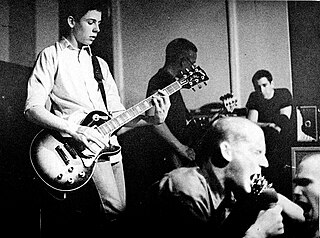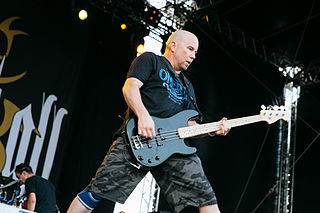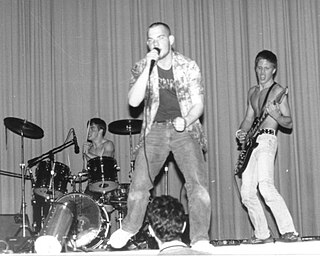Black metal is an extreme subgenre of heavy metal music. Common traits include fast tempos, a shrieking vocal style, heavily distorted guitars played with tremolo picking, raw (lo-fi) recording, unconventional song structures, and an emphasis on atmosphere. Artists often appear in corpse paint and adopt pseudonyms.
Death metal is an extreme subgenre of heavy metal music. It typically employs heavily distorted and low-tuned guitars, played with techniques such as palm muting and tremolo picking; deep growling vocals; aggressive, powerful drumming, featuring double kick and blast beat techniques; minor keys or atonality; abrupt tempo, key, and time signature changes; and chromatic chord progressions. The lyrical themes of death metal may include slasher film-style violence, political conflict, religion, nature, philosophy, true crime and science fiction.
Grindcore is an extreme fusion genre of heavy metal and hardcore punk that originated in the mid-1980s, drawing inspiration from abrasive-sounding musical styles, such as thrashcore, crust punk, hardcore punk, extreme metal, and industrial. Grindcore is considered a more noise-filled style of hardcore punk while using hardcore's trademark characteristics such as heavily distorted, down-tuned guitars, grinding overdriven bass, high-speed tempo, blast beats, and vocals which consist of growls, shouts and high-pitched shrieks. Early groups like Napalm Death are credited with laying the groundwork for the style. It is most prevalent today in North America and Europe, with popular contributors such as Brutal Truth and Nasum. Lyrical themes range from a primary focus on social and political concerns, to gory subject matter and black humor.

Hardcore punk is a punk rock music genre and subculture that originated in the late 1970s. It is generally faster, harder, and more aggressive than other forms of punk rock. Its roots can be traced to earlier punk scenes in San Francisco and Southern California which arose as a reaction against the still predominant hippie cultural climate of the time. It was also inspired by Washington, D.C., and New York punk rock and early proto-punk. Hardcore punk generally disavows commercialism, the established music industry and "anything similar to the characteristics of mainstream rock" and often addresses social and political topics with "confrontational, politically charged lyrics".
Thrash metal is an extreme subgenre of heavy metal music characterized by its overall aggression and fast tempo. The songs usually use fast percussive beats and low-register guitar riffs, overlaid with shredding-style lead guitar work.
Doom metal is an extreme subgenre of heavy metal music that typically uses slower tempos, low-tuned guitars and a much "thicker" or "heavier" sound than other heavy metal genres. Both the music and the lyrics are intended to evoke a sense of despair, dread, and impending doom. The genre is strongly influenced by the early work of Black Sabbath, who formed a prototype for doom metal. During the first half of the 1980s, a number of bands such as Witchfinder General and Pagan Altar from England, American bands Pentagram, Saint Vitus, the Obsessed, Trouble, and Cirith Ungol, and Swedish band Candlemass defined doom metal as a distinct genre. Pentagram, Saint Vitus, Trouble and Candlemass have been referred to as "the Big Four of Doom Metal".
A number of heavy metal genres have developed since the emergence of heavy metal during the late 1960s and early 1970s. At times, heavy metal genres may overlap or are difficult to distinguish, but they can be identified by a number of traits. They may differ in terms of instrumentation, tempo, song structure, vocal style, lyrics, guitar playing style, drumming style, and so on.

Crust punk is a subgenre of punk rock influenced by the English punk scene as well as extreme metal. The style, which evolved in the early 1980s in England, often has songs with dark and pessimistic lyrics that linger on political and social ills. The term "crust" was coined by Hellbastard on their 1986 Ripper Crust demo.
Extreme metal is a loosely defined umbrella term for a number of related heavy metal music subgenres that have developed since the early 1980s. It has been defined as a "cluster of metal subgenres characterized by sonic, verbal, and visual transgression".
Sludge metal is an extreme subgenre of heavy metal music that combines elements of doom metal and hardcore punk. The genre generally includes slow tempos, tuned down guitars and nihilistic lyrics discussing poverty, drug addiction and pollution.

Thrashcore is a fast-tempo subgenre of hardcore punk that emerged in the early 1980s. Thrashcore is essentially sped-up hardcore, adopting a slightly more extreme style by means of its vocals, dissonance, and occasional use of blast beats. Songs are usually very brief, and thrashcore is in many ways a less dissonant, minimally metallic forerunner of grindcore. The genre is sometimes associated with the skateboarder subculture.

Discharge are an English hardcore punk band formed in 1977 in Stoke-on-Trent, England. The band is known for influencing several sub-genres of extreme music and their songs have been covered by some of the biggest names in heavy metal and other genres. The musical sub-genre of D-beat is named after Discharge and the band's distinctive drumbeat.

D-beat is a style of hardcore punk, developed in the early 1980s by imitators of Discharge, after whom the genre is named, as well as a drum beat characteristic of this subgenre. D-beat is known for its "grinding, distorted and brutally political" sound. Discharge may have themselves inherited the beat from Motörhead and the Buzzcocks. D-beat is closely associated with crust punk, which is a heavier, more complex variation. The style was particularly popular in Sweden, and developed there by groups such as Crude SS, Anti Cimex, Mob 47, and Driller Killer. Other D-beat groups include Doom and the Varukers from the UK; Disclose from Japan; Crucifix and Final Conflict from the U.S.; Ratos de Porão from Brazil; and MG15 from Spain. While the style initially developed in the early 1980s, a number of new groups working within the subgenre emerged in the mid-1990s. These include the Swedish groups Wolfbrigade, Totalitär, Avskum, Skitsystem, and Disfear.
Earache Records is a British independent record label, music publisher and management company founded by Digby Pearson in 1985, based in Nottingham, England, with offices in London and New York. The label helped to pioneer extreme metal by releasing early grindcore and death metal records between the late 1980s and mid-1990s. Its roster has since diversified into more mainstream guitar music, working with bands such as Rival Sons, the Temperance Movement, Blackberry Smoke, Scarlet Rebels and the White Buffalo. The company also hosted the 'Earache Express' stage at Glastonbury Festival in 2017 and 'The Earache Factory' at Boomtown 2018. The label's logo is a homage to Thrasher magazine, as Pearson was a skateboard culture enthusiast.
Sore Throat were a British crust punk band formed in Huddersfield in 1987. They are known for being one of the earliest exponents of the grindcore subgenre known as "noisecore", as well as for launching the careers of several prominent members of the British heavy metal community.
Peaceville Records is a British independent heavy metal record label. The label was founded by Paul "Hammy" Halmshaw in Dewsbury, England, in 1987, who was also a one-time drummer of Sore Throat. Originally a tape label releasing anarcho punk, the releases moved towards metal through crust punk and similar forms of metal-influenced English hardcore punk. Halmshaw started running the label full-time in 1988, although the original tape label incarnation was founded in 1981 as a vehicle for releasing Instigators demo cassettes.
Crossover thrash is a fusion genre of thrash metal and hardcore punk. The genre lies on a continuum between heavy metal and hardcore punk. Other genres on the same continuum, such as metalcore and grindcore, may overlap with crossover thrash.

Powerviolence is an extremely dissonant and fast subgenre of hardcore punk which is closely related to thrashcore and grindcore. In contrast with grindcore, which is a "crossover" idiom containing musical aspects of heavy metal, powerviolence is just an augmentation of the most challenging qualities of hardcore punk. Like its predecessors, it is usually socio-politically charged and iconoclastic.
Stoner rock, also known as stoner metal or stoner doom, is a rock music fusion genre that combines elements of doom metal with psychedelic rock and acid rock. The genre emerged during the early 1990s and was pioneered foremost by Kyuss and Sleep.







